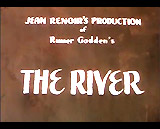
|
The River (1951, Fr./India) (aka
Le Fleuve)
In Jean Renoir's beautiful, meditative coming-of-age
romantic drama - the director's first color film, filmed on location
in India (with many semi-documentary, authentic scenes of Ganges
River life and Hindu religious festivals), and based upon Rumer
Godden's autobiographical novel - it was the first Technicolor film made in
India:
- the thematic opening symbol of a circle with filagrees
(accompanied by a soundtrack of sitar raga music) - in the film's
beginning, a decorative circle was designed and drawn in rice paste
(rice flour and water) on a courtyard's floor, by disembodied hands
- to welcome guests
- the flashbacked, opening semi-autobiographical
sequences that were narrated (in voice-over) by a
free-spirited adult Harriet (narrator voice-over by June Tripp),
who wisely looked back on her idyllic life as a young girl in Bengal,
India (in the post-war mid 1940s) - it was a story of adolescent
first love: "It is the story of my first love, about growing up
on the banks of a wide river. First
love must be the same any place, and it might have been in America,
England, New Zealand, or Timbuktu, though they do not, of course,
have rivers in Timbuktu. But the flavor of my
story would have been different in each, and the flavor of the
people who live by the river would have been different"
- the film emphasized the symbolism and central motif
of the River naturally ebbing and flowing through cycles and seasons,
along with various Hindu festivals of the calendar year, and creation
and destruction, including life, death, and rebirth: (the narrated
voice-over of Harriet continued) "It
was one of the many holy rivers. Its waters came from the eternal
snows of the Himalayas and emptied into the Bay of Bengal. The
river had its own life: fishes and porpoise, turtles and birds,
and people who were born and lived and died on it. It flowed slowly
between banks of mud and white sand, rice fields and jute fields. The
jute grew in flat marshes, nourished by monsoon floods. Country
boats of all shapes and sizes brought the jute to the factories.
Some of them came from as far away as Assam and Chittagong, and
the borders of Burma through the winding arteries of the delta.
The workmen carried their heavy loads. For each load, a seashell.
So many shells, so many loads. Jute was the reason we lived in
India. Our whole life depended on it. My father was in charge of
a jute factory"
- the descriptions provided by Harriet introduced
how she lived in a walled or gated compound (protectively guarded
by an elderly, ex-soldier Sikh from the Punjab named Ram Singh)
with her British colonial family - her jute-factory manager-father
(Esmond Knight), her mother (Nora Swinburne), her four younger
sisters (including twins Muffy and Mouse) and animal-loving, inquisitive
brother Bogey (Richard Foster) (often playing with native boy Kanu
(Nimai Barik) and interested in turtles and snake-charming), along
with a native nursemaid Nan - all in a house near the banks of
the Ganges River; Nan (Suprova Mukerjee) was lovingly described
as "the bridge to life, bringing us back from dreams to reality,
from reality to dreams...Nan, always filling our heads with tales
of romance, setting the stage for the arrival of love"
- the main character was poet-writing,
day-dreaming Harriet (Patricia Walters) at
the awkward adolescent age of 13, who thought of herself as less than beautiful: ("I see
myself an ugly duckling determined to be a swan")
- her life was very much influenced by the arrival of her
new neighbor ("Then, as the river brought everything, it brought
a young man on the weekly steamer") - it was the brooding and still-traumatized
US war veteran-hero Captain John (Thomas E. Breen) (suffering the
loss of one leg during the war, and wearing an artificial limb),
the cousin of widower neighbor Mr. John (Arthur Shields)
- Harriet faced romantic
competition from two other females:
- her older 18 year-old, precocious red-headed friend Valerie
(Adrienne Corri), the daughter of the wealthy jute-factory owner
- 20-ish, Indian-born Melanie John (Indian dancer Radha Burnier),
the Anglo-Indian, caste-less daughter of Mr. John (and his wife - a
deceased Indian national), with mixed ethnicity and some identity confusion
(and problems with feeling like she didn't belong: "Someday I will
find out where I belong"), who had just graduated from a British boarding
school and returned home
- the many sequences of Indian culture and religion,
including the annual celebration of the festival of Dewali (festival
of lights), and narration about the Hindu religion and the worship
of the statue-image of Kali - "Goddess of Eternal Destruction and
Creation, creation being impossible without destruction...the great
terrifying Kali held court in all her magnificence, and the villagers
gathered to ask protection from disease and famine and fire - for
through destruction of the elements of evil, good is born" - a portent
of things to come
|
Kali - The Goddess of Eternal Destruction and Creation
|
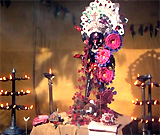
|
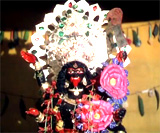
|
- the symbolic pipal (banyan) tree within the gated
compound, where Bogey and his native friend Kanu would often play,
as Harriet described: "From its branches grew tentacles deep into
the ground. The tree was like a dwelling - a labyrinth where many
mysteries were hidden. The pipal tree is sacred to Hindus for many
reasons. It was under such a tree that prince Gautama sat in meditation,
and rose to the highest heights of enlightment to become the Lord
Buddha"; one day, the boys spotted a deadly cobra slithering among
the tentacles
- the long sequence of Harriet's eight-minute dream
story, a film-within-a-film, to Captain John and Valerie, about the
cyclical life of a mythical rural Indian woman from the time of her
birth to her own marriage and maternity: ("Once
upon a time, in a small village, a young wife went with her mother
to the river to ask for the blessing of a child. They offered prayers
and flowers. After the right number of months, they had a little
girl. They were disappointed because she was not a boy....We had
to think about getting a dowry for the baby...They had to work harder
and harder every day to get this dowry. They loved the baby and she
was very well looked after. She was indeed a lovely child. And soon
she began to help her parents. Every day she grew bigger and bigger.
She also had her river and like the river, her life flowed on and
on, until she was a grown-up person. She was not only beautiful on
the outside, but on the inside as well...")
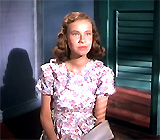
|
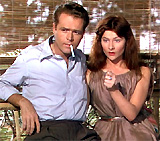
|
Valerie and Captain John Listening
to Harriet's Lengthy Dream Story
|
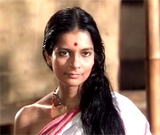
|
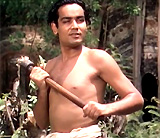
|
|
Indian Girl Grown-Up
|
She Fell in Love with Young Man
|
- Harriet's story continued about how the young girl
grew up, she caught sight of a good-looking man she
believed to be an incarnation of Lord Krishna - and she fell in love;
unfortunately, her father had planned a customary arranged marriage
for her and she resisted: ("One day near an old temple, she saw a
young man. He was so beautiful, she thought he was the Lord Krishna
come down to earth. Then her father told her she had to marry a man
of his choice. That's the ancient custom. She was terribly unhappy
because she could not help remembering the young man she had seen
at the temple. As an Indian girl never contradicts her father, she
made herself ready for the wedding and worked hard to make it really
beautiful. The courtyard was painted with rice flower, the house
was decorated, the guests came. The bridegroom arrived. The bride's
mother welcomed him. She was very unhappy. She was carried around
the bridegroom to tie the knot for life. He was hidden by a veil.
Then, the veil was lifted. And when she removed the mango leaves
covering her eyes, she saw his face. Lo and behold. It was the young
man she loved.")
- during the Hindu wedding ceremony, she
was pleasantly surprised that the groom was none
other than the boy she loved; also, flute-playing
Lord Krishna (the human embodiment of Vishnu, a Hindu deity) intervened
to assume the identity of the high-caste suitor/groom (family friend
Anil (Trilak Jetley)), and the bride (personified as Harriet's friend
Melanie (Radha Burnier)) was also temporarily and magically transformed
into Krishna's consort Radha (a cow-herding maiden); as a result, the
bride took on a new view of her chosen husband - Harriet's story continued:
("She was very happy. He was transformed into the Lord Krishna;
she was transformed into
the lady Radha. The real Radha who lived thousands and thousands
of years ago was also a country girl. The love of the god made her
a goddess. She danced to express her love for him. (She performed
a lengthy and joyful Bharata-natyam ritualistic dance in a sublime
sequence) With her hands and her eyes, she said to him, 'O Krishna,
you are as beautiful as a monsoon cloud. Your eyes are like the lotus
in bloom. O Krishna, I want to be always in your presence. O Krishna.'
The lady Radha became the village bride again. The Lord Krishna again
became the bridegroom. And the young wife went with her mother to the
river to ask for the blessing of a child"); the sequence ended with
the young wife going to the river where she prayed to be blessed with
a child; the story illustrated how a man and woman could become gods
through love, and how the cycle of life continued
|
Harriet's Dream Tale of a Marriage
|
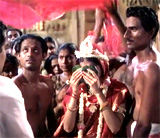
|
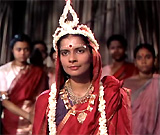
|
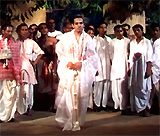
|
|
Bride With Covered Eyes Before Bridegroom
|
Bride
|
Groom
|
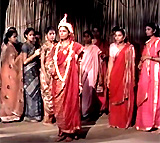
|
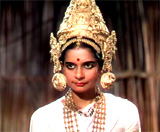
|
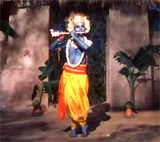
|
|
Bride: "She was very happy"
|
Bride Transformed into Radha - a Goddess
|
Bridegroom Transformed into Flute-Playing Lord Krishna
|
- the sequence that illustrated the rivalry between
Harriet and Valerie occurred when Valerie grabbed Harriet’s
diary and embarrassed her by reading excerpts of Harriet's infatuation
with Captain John to his face, such as "His face is like a sensitive
flower" - she was mortified and told them: "I'll never forgive you,
never! I could kill you both!"; even Captain John thought Valerie's
intrusion into Harriet's "secret" diary was wrong
- immediately afterwards, Valerie forced Captain
John to join her ("Can you play?") in a light-hearted game
of catch (tossing a ring); when Captain John reached for the ring
in the air and collapsed on the ground, he exhibited wounded pride
as he shouted at Valerie: "Leave
me alone. Get away from me, I said. Leave me alone. Don't touch me";
he showed his internal struggle with feeling like an outsider
due to his one-leggedness;
his fall due to his disability reminded him of his weakness
- later, Captain John made
plans to leave and continue his travels to find himself, and told
Melanie: "It's the same story anywhere I go. I spoil everything.
I can't seem to help it. I'm a stranger," but he was determined
to not be bound by his missing leg: "I'm a normal man in any
country"
- she responded: "Where will you find a country of one-legged
men?"
- they both faced issues of outsider-status and self-loathing; she
told him: "It is not you I dislike....(it is) myself"; ultimately,
although Captain John had a mature interest
in Melanie, but there were too many insurmountable cultural and personal
differences between them (including racial taboos about a white American
romancing an Indian female) and they realized they couldn't be in
a serious relationship
- the scene in a grove in the forested estate near
the river bank of a jealous Harriet (and Melanie)
spying upon and witnessing an apology between Captain John and an
"impetuous" Valerie (who brought him a gift of flowers
even after he had treated her rudely); Harriet recalled: "The
kiss on her lips. Terrifying and fascinating burned into my heart
in hurt. It
was my first kiss but received by another. I couldn't bear it";
it
caused her to become increasingly depressed; the melancholy Valerie
shed some tears and explained how his departure meant that she had
grown-up and her fanciful and youthful dreams were ending: "This,
being together, in the garden. All of us happy, and you with us here,
I didn't want it to change, and it's changed. I didn't want it to
end - and it's gone. It was like something in a dream. Now you've
made it real. I didn't want to be real"
- the lyrical interlude napping sequence shot in the
lazy late-afternoon later the same day, when many of the major characters
(and servants) were taking a nap - the camera cycled through the
individuals with transitional dissolves, and in/out tracking shots;
however, in the next sequence, Harriet found a lifeless Bogey who
had been bitten by a cobra (off-screen) who lived around the roots
of a giant pipal (banyan) tree - he was sprawled on the ground
and also appearing to be napping [Note: earlier, Bogey had been
seen entranced by a snake charmer in town, and disobediently was
attempting to lure the snake at the tree with his own flute.]
|
Nap-Time Sequence
|
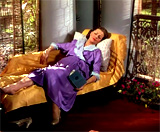
|
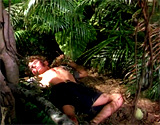
|
|
In the House
|
Young Bogey Dead by Tree
|
- the scene of Bogey's funeral, including a procession
with his flower-decorated wooden coffin; Mr. John delivered a brief
soliloquy to Captain John after Bogey’s death - he toasted
and celebrated the wonders of childhood, but worried that the world
wasn't made safe for children: ("I drink to the children. We
should celebrate that a child died a child, that one escaped. We
lock them in our schools. We teach them our stupid taboos. We catch
them in our wars and they can't resist. They've no armor, and so
we kill them. We massacre the innocents. And the world is for children – the
real world. They climb trees and roll in the grass. They’re
close to the ants and as free as the birds. They’re like animals.
They’re
not ashamed. They know what is important. A mouse is born or a leaf
drops in a pond. If the world could be made of children...")
-
the sequence of the very depressed Harriet (who blamed herself for
her brother's death) - who decided to run away from home by
floating down the river in an unattended canoe-like skiff; she
failed in her suicide attempt to drown herself in the river by
jumping overboard when saved by some fishermen - and the aftermath
when she was resting in the comforting arms of Captain John, feeling
rescued or reborn; he embraced her, and she said she loved him;
he kissed her on the forehead - and she was thankful ("Now you've
kissed me as well as Valerie") before he was to take her
home; Harriet asked: "Who's important to you, Captain John?" and
he answered: "Everybody"
- in the final scene, the three females (Harriet, Melanie,
and Valerie) each received separate letters from Capt. John (who
had returned to the US) and as they were reading them on the front
steps, they became completely distracted, dropped the letters, and
ran inside when they heard the sounds of a squalling baby; the live-in
house nanny announced the birth of another girl: ("It's
a girl!")
- the three females mused on the porch how the circle
of life was repeating itself -
Harriet exclaimed: "Ten minutes ago, she wasn't born. And,
tomorrow, we'll be used to her. And yesterday, we..."; Valerie interrupted:
"Bother yesterday", and Melanie added: "This is today!"; Harriet
finished her thought: "And today. Here is the baby. The baby and
us. The big river. The whole world and everything"; the camera
rose up above the girls and focused on the river in the distance
- Rumer Godden's lyrical poem (narrated in voice-over)
ended the film (although it was stated earlier in the film): "The
river runs. The round world spins. Dawn and lamplight, midnight,
noon. Sun follows day – night,
stars, and moon. The day ends. The end begins"
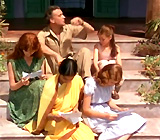
|
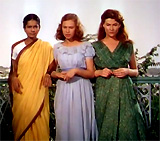
|
|
The Three Females Reading Separate Letters from
Capt. John as a New Girl Was Born
|
Final Thoughts on Birth of Baby
|
|
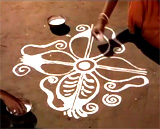
Opening: Circle Drawing
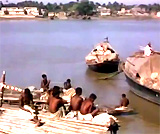
Opening Views of the Ganges River
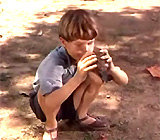
Young Bogey - the only male
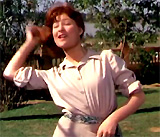
Red-Headed Neighbor Valerie
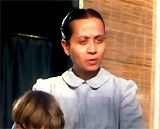
Nan: "The Bridge to Life"
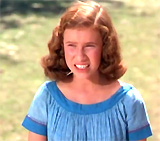
13 Year-Old Harriet (Patricia Walters)
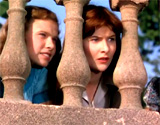

Harriet with Valerie - Watching and Talking About the
Arrival of Captain John
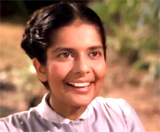
Melanie John
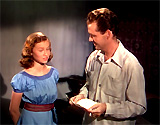
Harriet with Captain John
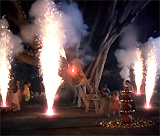
The Scene of the Family's Celebration of the Festival of Dewali

Harriet with Melanie John
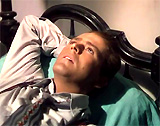
Brooding War 'Hero' Captain John
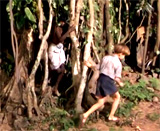
The Pipal (Banyan) Tree
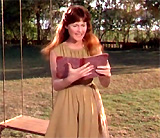
To Embarrass Harriet, Valerie Stole Her Diary and Read Excerpts to Captain
John About Her Infatuation With Him
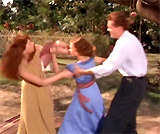
Fighting Over the Diary
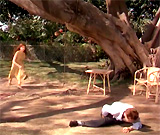
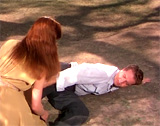
Valerie's Ring-Toss Scene With Captain John
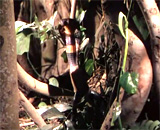
The Cobra in the Banyan Tree
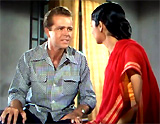
Captain John to Melanie: "I'm a stranger"
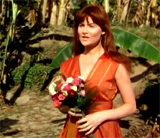
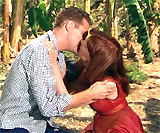
Captain John Kissing Valerie
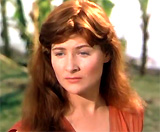
Valerie's Tears Explained
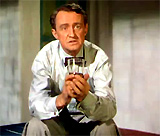
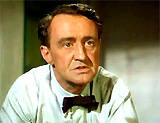
Ode to the Deceased Young Bogey and Children in General by Mr. John
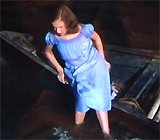
Harriet's Attempted Suicidal Drowning
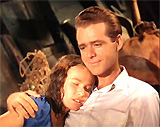
After Harriet's Rescue - in the Arms of Captain John
|




























